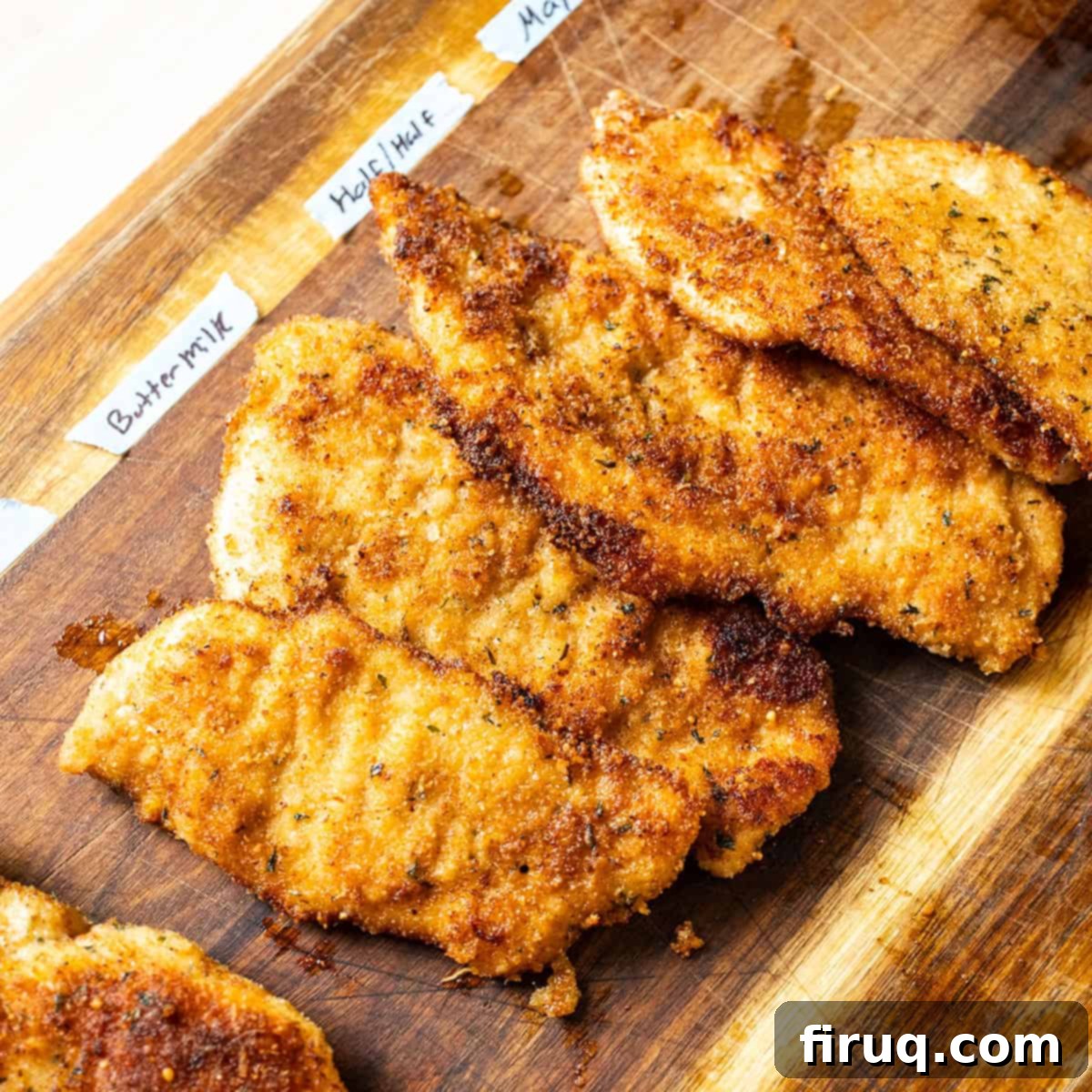Delicious Chicken Cutlets Without Eggs: 5 Best Substitutes for Perfect Crispy Batter
For many, particularly in Italian households, a perfectly crispy chicken cutlet is more than just a meal – it’s a tradition, a comfort, and a cornerstone of home cooking. The classic method relies heavily on eggs to bind the flavorful breadcrumbs to the tender chicken. However, with fluctuating egg prices, dietary restrictions, allergies, or simply running out of eggs mid-week, finding reliable alternatives to make chicken cutlets without eggs has become incredibly important. Fear not, fellow food enthusiasts! I’ve experimented with and perfected 5 solid alternatives to batter your chicken cutlets that deliver fantastic results, ensuring your family doesn’t miss out on this beloved dish.
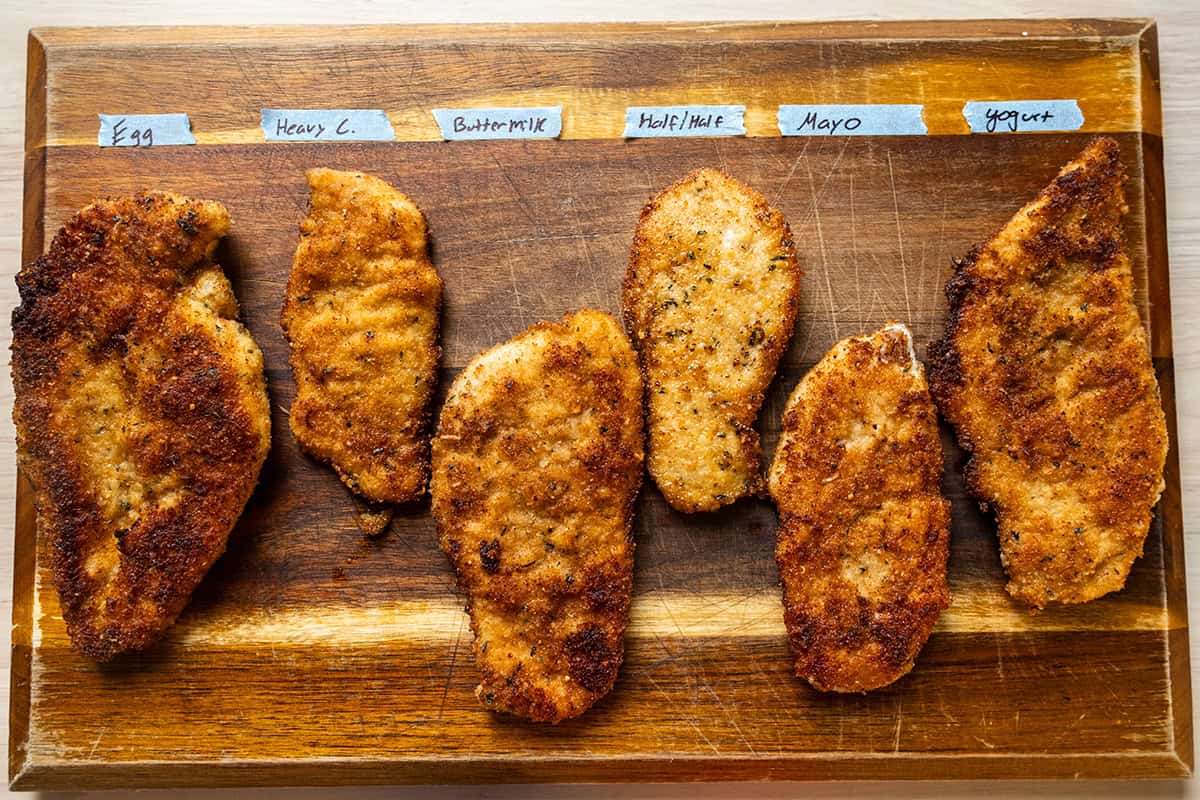
For most Italian-Americans, chicken cutlets are indeed like a religion, deeply ingrained in culinary tradition. The thought of substituting an egg in this sacred process might seem like a sacrilege to some purists. However, the practicalities of modern life often demand flexibility in the kitchen. Whether you’ve unexpectedly run out of eggs, are facing exceptionally high egg prices, dealing with an egg allergy in the family, or simply need to get a delicious dinner on the table quickly, these alternative batters will ensure your chicken cutlets are still tender, juicy, and perfectly crispy.
If you’re looking to master the art of crispy fried chicken, you might also want to explore our guide on the best Italian Chicken Cutlets recipe or learn What Oil to Fry Chicken Cutlets with for optimal crispiness and flavor.
[feast_advanced_jump_to]
Best Egg Substitutes for Battering Chicken Cutlets
After extensive testing and culinary exploration, I’ve compiled a list of the top 5 egg substitutes that work wonderfully for breading chicken cutlets. These options not only replace the egg but also bring unique flavors and textures to the final dish. While all five are solid choices, I’ve ranked them from my absolute favorite to the one I’d use if other options weren’t available. Keep reading for detailed notes on each to help you choose the perfect substitute for your next batch of crispy chicken!
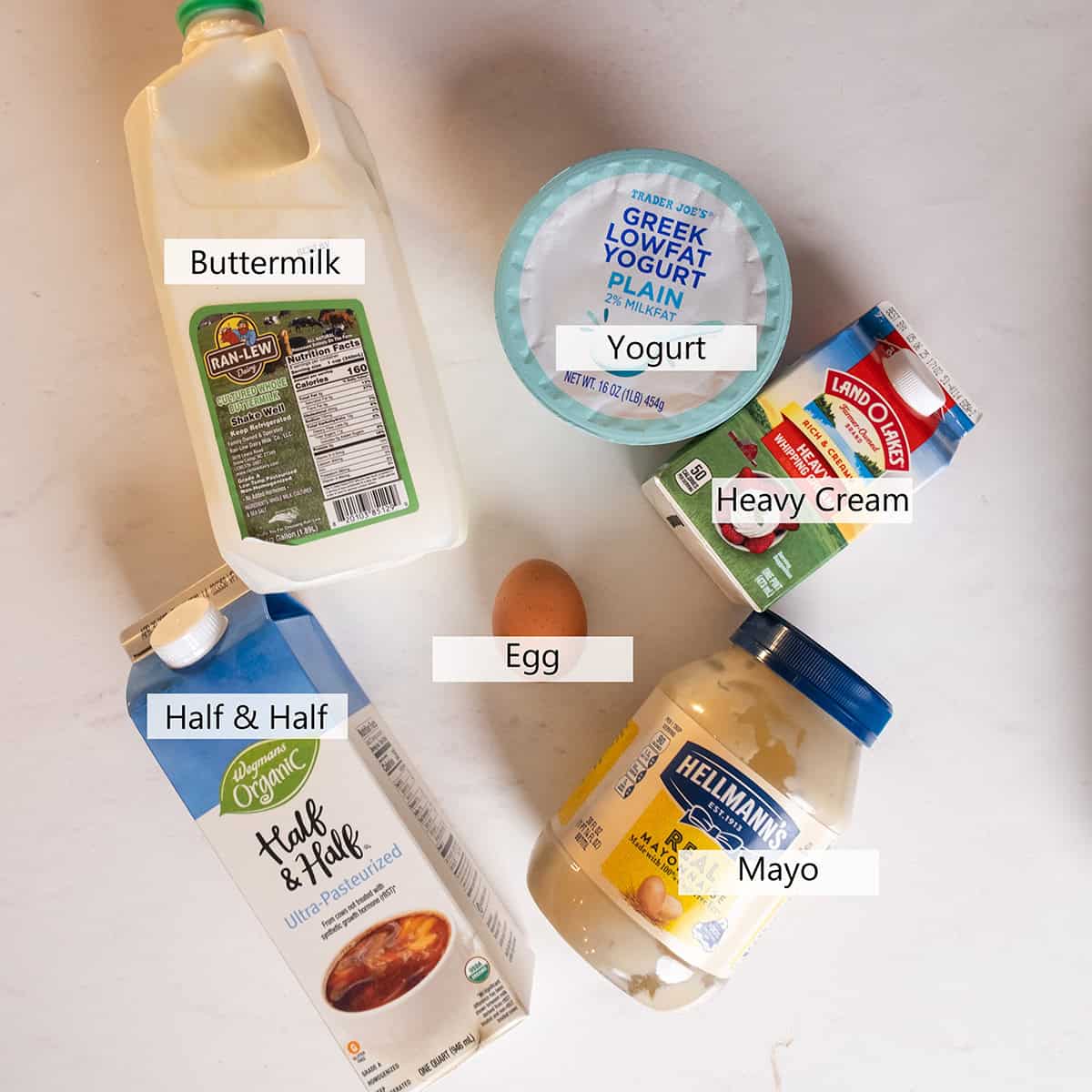
Here’s my definitive ranking, from the best egg substitute to the one that works in a pinch:
- Heavy Cream
- Buttermilk
- Mayonnaise (Mayo)
- Yogurt
- Half and Half
Detailed Analysis of Each Egg Substitute for Chicken Cutlets
While there are many ingredients that can technically serve as an egg substitute in various recipes, for Italian Chicken Cutlets, we’re specifically looking for properties that ensure a crispy, golden crust and a satisfying flavor. Below, I’ll focus on the five best alternatives and how each impacts the taste, texture, and overall success of your chicken cutlets.
1. Heavy Cream: The Closest Match to Egg Batter
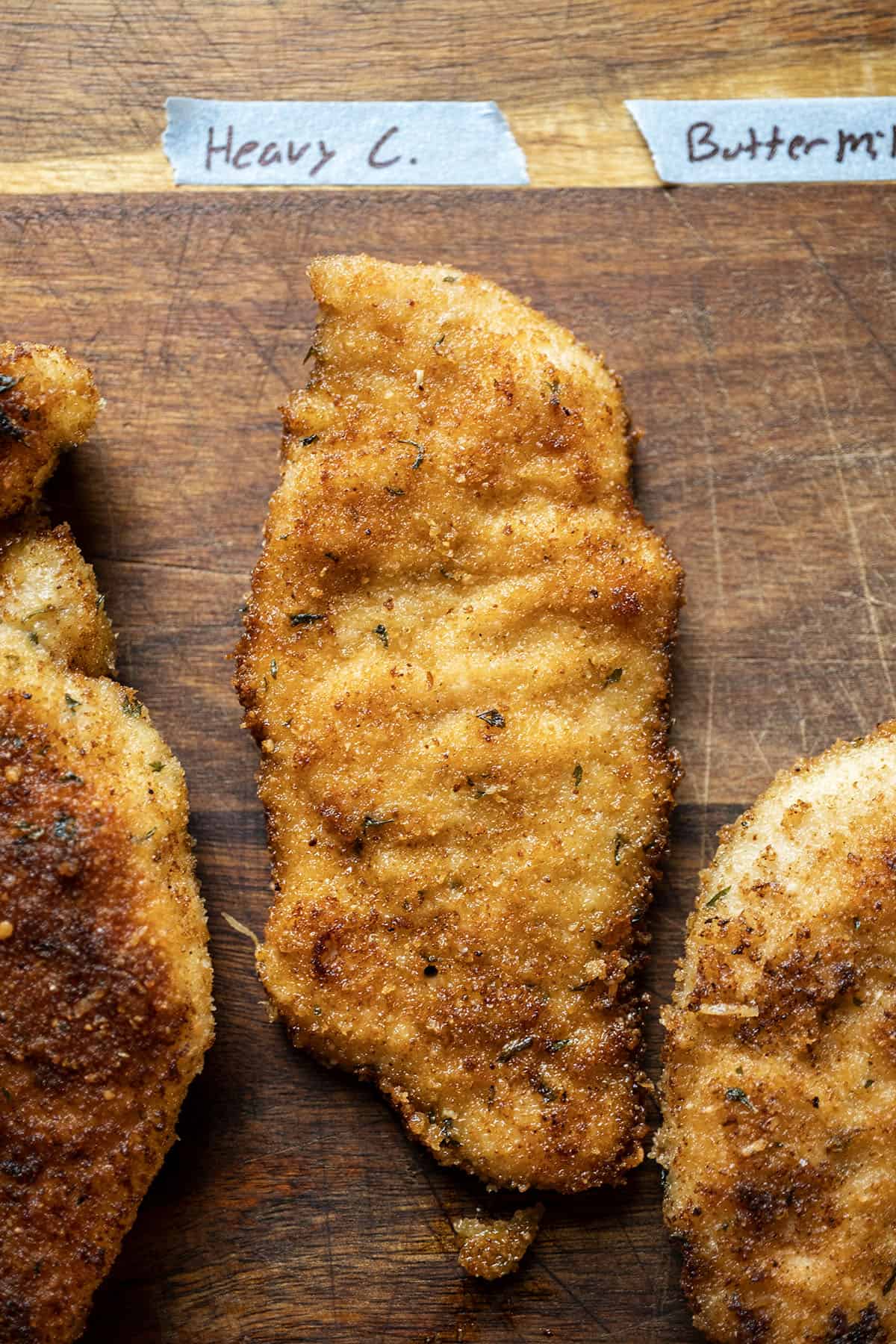
Taste: Heavy cream is, without a doubt, the closest you’ll get to the classic taste of an egg-battered chicken cutlet. Its high fat content contributes to a rich, savory flavor that complements the chicken and breadcrumbs beautifully. It’s slightly richer than an egg, but the difference is subtle and generally enhances the overall deliciousness without drastically altering the traditional profile.
Texture: The texture achieved with heavy cream is almost identical to using eggs. The cream provides excellent adhesion for the breadcrumbs, ensuring they bind well to the chicken and create a wonderfully crisp crust when fried. You’d be hard-pressed to tell the difference; the breadcrumbs won’t easily slip off, maintaining that desirable crunchy exterior.
Would I substitute?: Absolutely, yes. Heavy cream is my top recommendation as a direct substitute for eggs in chicken cutlets. In fact, if I were running low on eggs, I would even consider combining a single egg with heavy cream to stretch my ingredients and still achieve superior results. Its consistency and fat content make it an ideal choice for maintaining the integrity of your crispy coating.
2. Buttermilk: For a Tangy and Tender Crunch
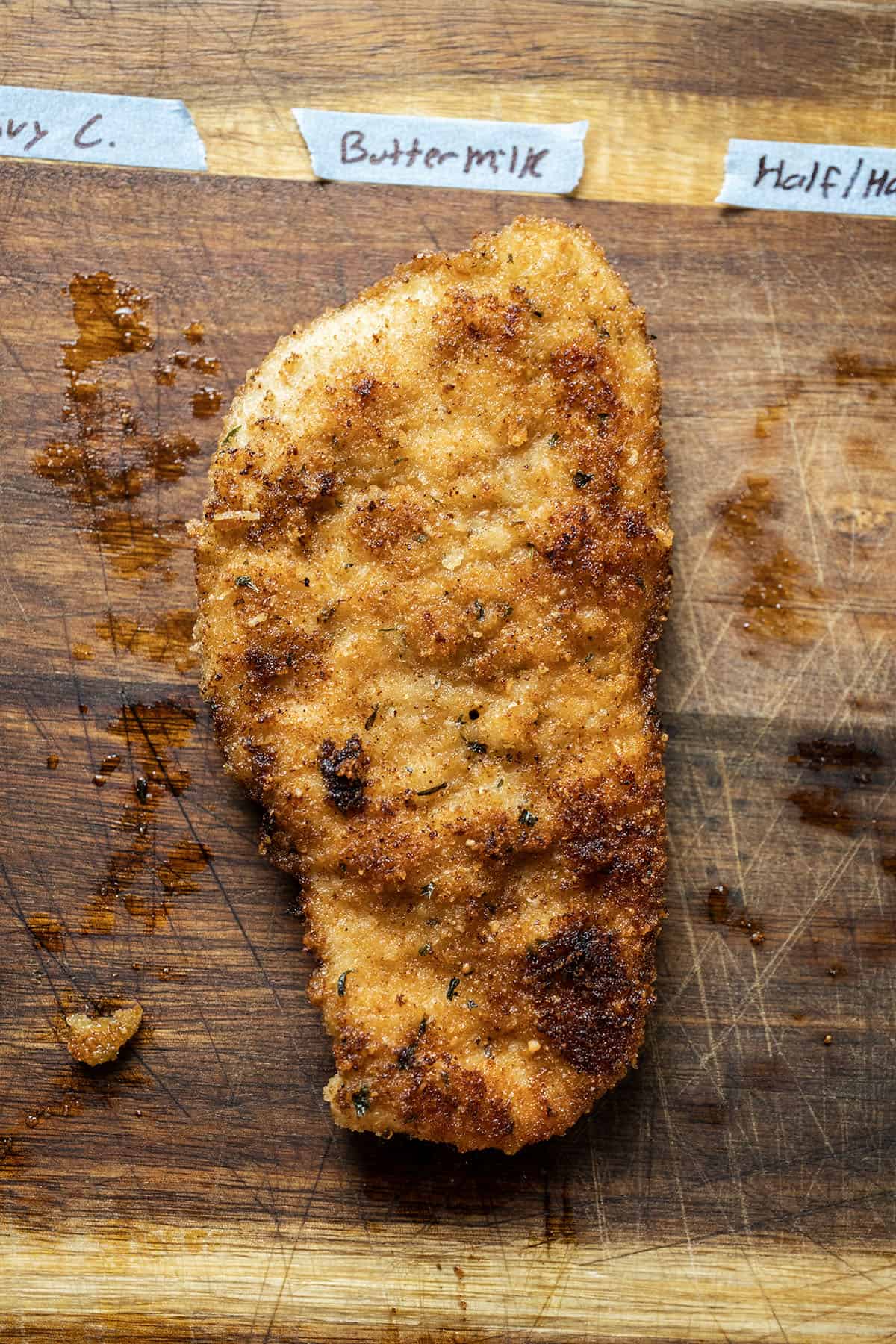
Taste: Buttermilk brings a delightful, slightly tangy flavor to the chicken cutlet, reminiscent of Southern fried chicken. The subtle acidity from the buttermilk’s lactic acid tenderizes the chicken, adding an extra layer of moisture and a pleasant “bite” that I personally find incredibly appealing. If you enjoy a hint of zest, this is a fantastic option.
Texture: The texture is also outstanding. Buttermilk is a naturally thicker liquid than a whisked egg, which allows it to create a more substantial coating for the breadcrumbs. This results in an incredibly satisfying crunch when fried. The breading adheres very well, forming a robust and crispy exterior that holds up beautifully.
Would I substitute?: Absolutely, and enthusiastically so! I would not only use buttermilk as an egg substitute but would also intentionally make buttermilk cutlets just for the distinct and delicious flavor it imparts, even when eggs are readily available. It offers a wonderful deviation from the classic that is still universally loved.
3. Mayonnaise: A Smart & Economical Alternative
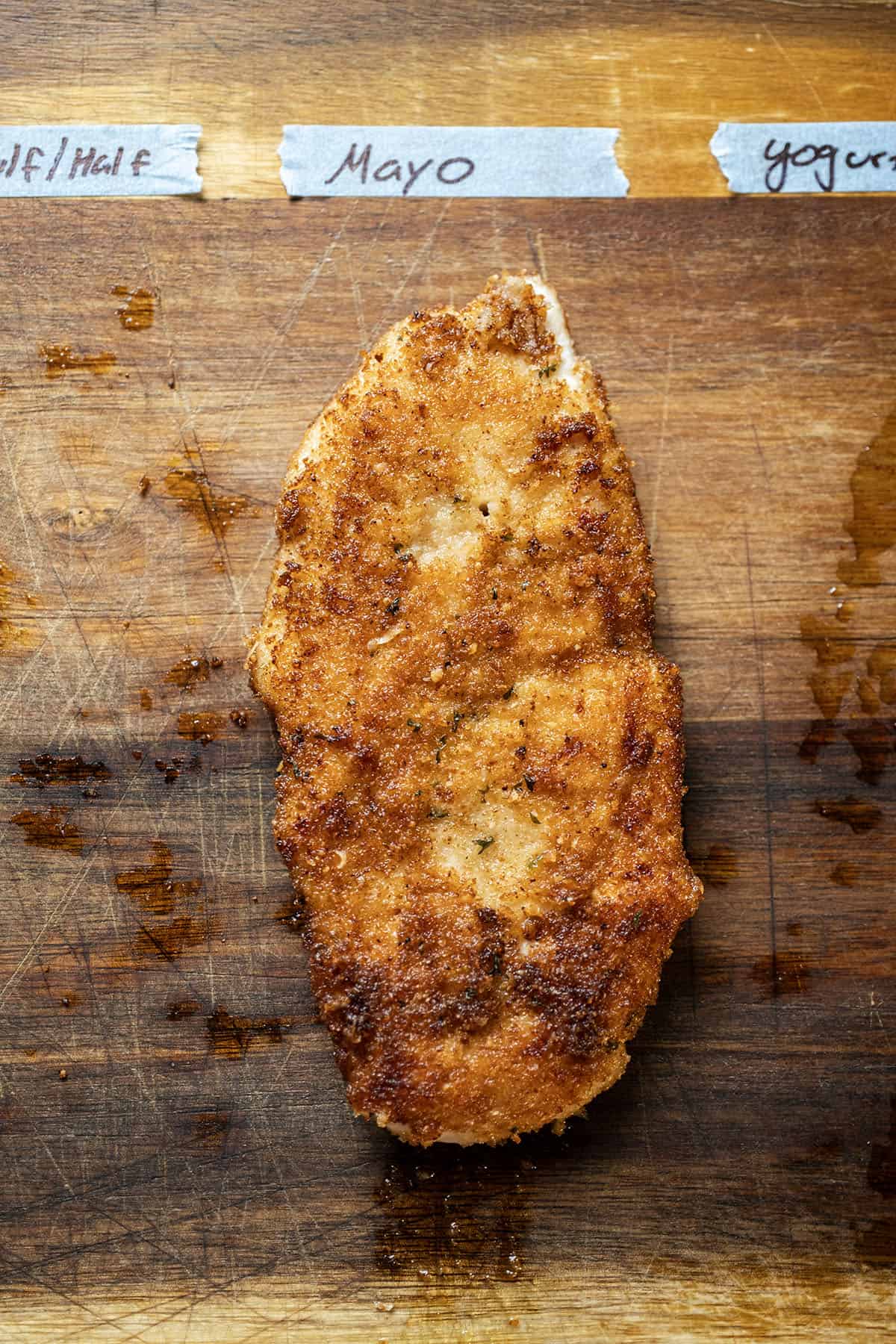
Taste: You might be surprised, but you can faintly taste the mayonnaise in the final product. This is a trick my grandmothers often used when eggs were scarce or too expensive, as mayo is generally more budget-friendly. While the flavor is definitely affected—a bit tangier and richer than traditional egg—it’s not necessarily a bad thing. It’s just different, which is why it’s ranked below heavy cream and buttermilk for maintaining a classic Italian profile.
Texture: The main challenge with mayonnaise is its binding power. While it contains eggs and oil, its consistency means it doesn’t adhere as strongly as a raw egg. If you’re not careful when handling the breaded cutlets (e.g., using tongs too forcefully), the breading can sometimes slip right off. To improve adhesion, ensure your chicken is patted very dry before dipping, and press the breadcrumbs firmly onto the mayo-coated surface.
Would I substitute?: In a pinch, absolutely. Mayo is a viable option when you have no other choice, and it can still produce a tasty cutlet. However, I would prioritize heavy cream or buttermilk first due to their superior binding and more traditional flavor profiles. Think of mayo as your reliable backup plan.
4. Yogurt: A Tangy Twist with Binding Challenges
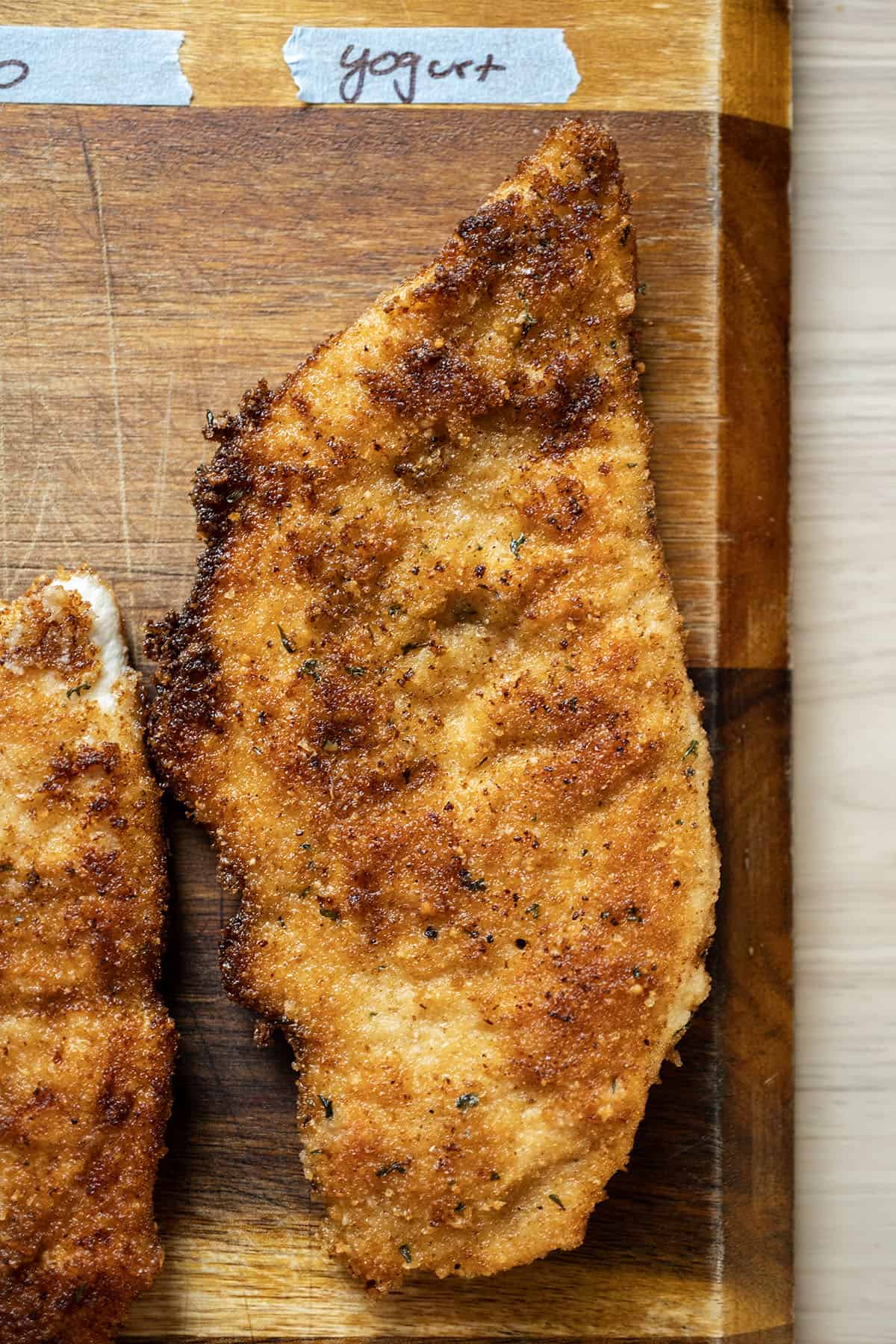
Taste: As expected, plain yogurt imparts a noticeable sour flavor. While it’s a good flavor in its own right, it’s not typically what you’d anticipate from an Italian Chicken Cutlet. It leans more towards a marinade you’d find in Middle Eastern or Indian cuisine, offering a fresh, bright tang.
Texture: Yogurt can create a good, crunchy texture, but I found that it tended to stick to the pan more than other batters. This often resulted in some areas of the cutlet losing their breading during frying, leaving an unevenly coated, or sometimes bare, patch. Using a well-seasoned, non-stick pan and not overcrowding can help mitigate this, but it’s a consistent challenge.
Would I substitute?: Not as a first choice for an Italian chicken cutlet. If I were making a dish where a sour or tangy profile was desired, like a butter chicken or chicken tikka masala, then yogurt would be an excellent choice for a marinade and tenderizer. But for a traditional Italian fried chicken cutlet, it deviates too much from the expected flavor and presents too many binding issues.
5. Half and Half: A Lighter Option with Limitations
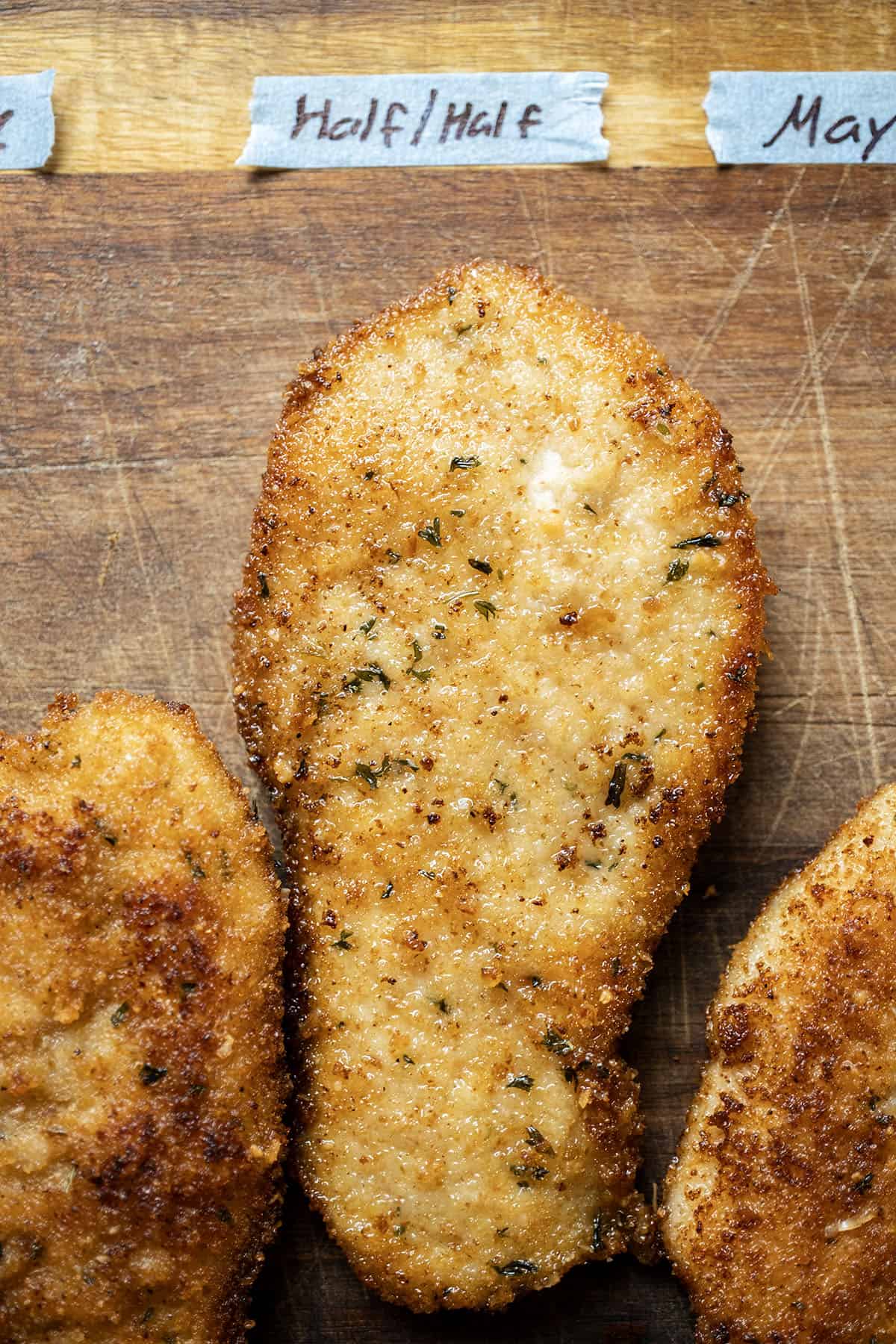
Taste: The taste of chicken cutlets battered in half and half is generally fine—neither exceptionally good nor bad. It lacks the richness of heavy cream, which isn’t always a negative, especially if you prefer a lighter profile. However, it also doesn’t add any distinctive flavor notes that enhance the dish.
Texture: Unfortunately, half and half proved to be the weakest binder among the dairy options. Its lower fat content and thinner consistency mean it doesn’t adhere as effectively to the chicken or hold the breadcrumbs as well as heavy cream or even buttermilk. The cutlets didn’t fry as evenly, and the breading had a tendency to be less robust, sometimes failing to provide a consistently crispy coat.
Would I substitute?: I would likely avoid using half and half as a standalone substitute due to its binding limitations. However, if I found myself with only one egg and needed to stretch it for a larger batch of cutlets, I might consider whisking it with the half and half. This could boost the volume and some of the binding properties, making it a more viable, albeit still not ideal, option.
The Control Subject: Egg Batter
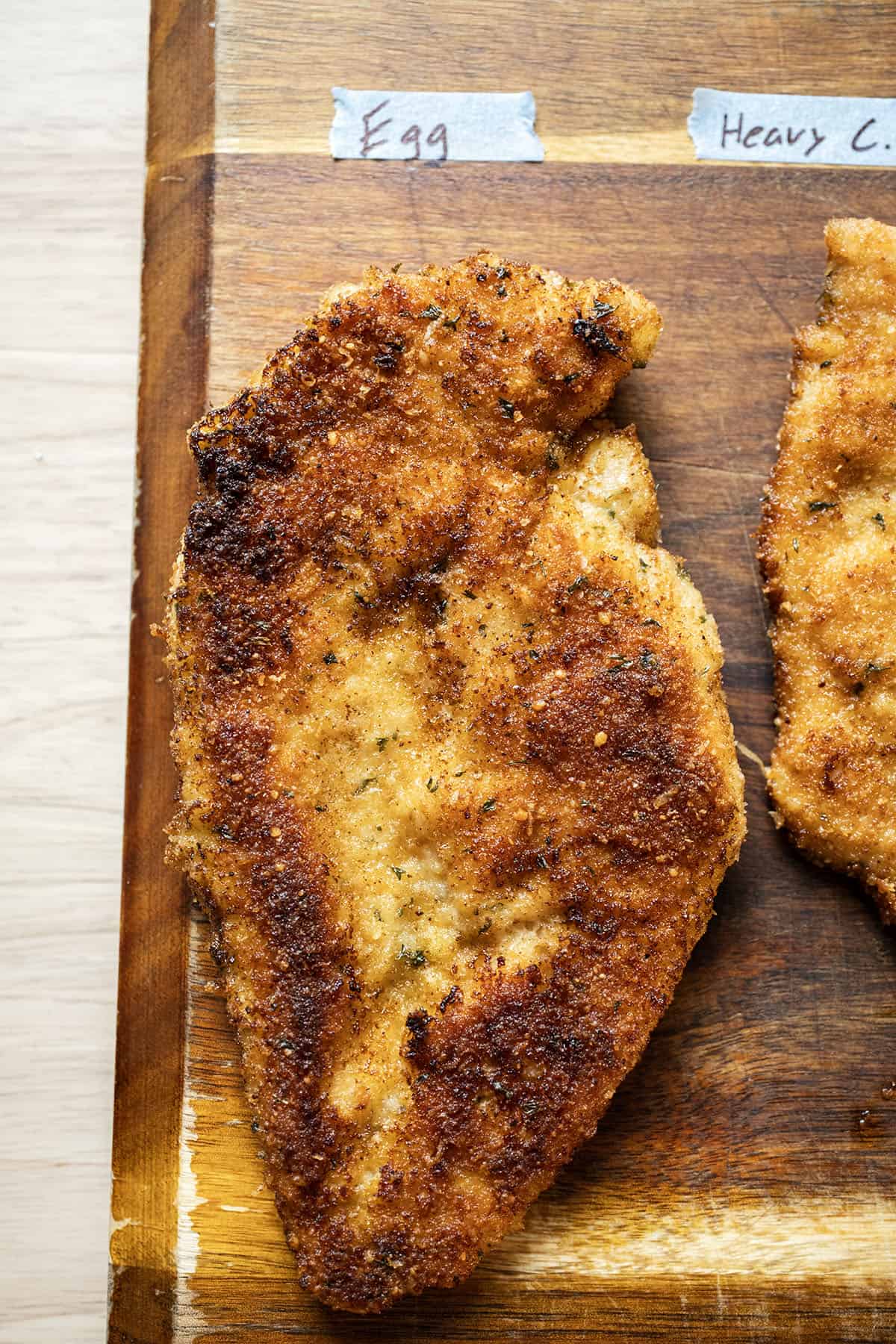
It’s important to acknowledge the benchmark: the traditional egg batter. The egg remains the gold standard because it acts as an exceptional binder, creating a sticky surface that firmly holds the breadcrumbs and crisps up beautifully when fried. It provides a neutral yet rich flavor and an unparalleled crispy texture that most of these substitutes aim to replicate. If you have eggs, and no dietary restrictions, they are undoubtedly your best option for classic chicken cutlets.
How to Make Delicious No-Egg Chicken Cutlets
Regardless of which egg substitute you choose, the basic method for preparing and frying chicken cutlets remains largely the same. Here’s a simple step-by-step guide to help you achieve perfectly crispy, egg-free chicken cutlets:
Step 1: Prepare Your Chicken Cutlets. For detailed guidance on preparing your chicken, you can follow our complete directions in my Italian Chicken Cutlets recipe. The most crucial first step is to slice the chicken breasts really thin. This ensures even cooking, faster frying, and maximum crispiness. Pounding them lightly between two sheets of parchment paper can also help achieve uniform thickness.
Step 2: Season Your Breadcrumbs. Don’t underestimate the power of well-seasoned breadcrumbs! In a shallow dish or plate, combine your breadcrumbs with fresh chopped parsley, grated Parmigiana cheese, garlic powder, and a generous pinch of salt. You can also add black pepper, onion powder, or a hint of dried oregano for extra flavor. Mix thoroughly to ensure the seasonings are evenly distributed.
Step 3: Batter and Dredge. This is where your chosen egg substitute comes in. Pour your selected batter (heavy cream, buttermilk, mayo, yogurt, or half and half) into a separate shallow dish. Take each thinly sliced chicken cutlet, dip it completely into the batter, ensuring both sides are fully coated. Let any excess drip off, then immediately transfer the cutlet to your seasoned breadcrumb mixture. Press the breadcrumbs firmly onto both sides of the chicken, ensuring a thick, even coating. This firm pressing is key to good adhesion, especially with alternative batters.
Step 4: Fry to Golden Perfection. Heat about ½ inch of olive oil (or your preferred frying oil) in a large frying pan over medium heat. It’s important to let the oil get hot enough before adding the chicken to ensure a crispy crust and prevent sogginess. Carefully place the breaded cutlets into the hot oil, being mindful not to overcrowd the pan. Fry the cutlets for approximately 3 minutes on each side, or until they are beautifully golden brown and cooked through. Once fried, transfer them to a wire cooling rack placed over a paper towel-lined baking sheet to allow excess oil to drain and keep them crispy. Let them rest for a few minutes, then serve immediately with your favorite sides!
Top Tips for Battering Chicken Cutlets Without Eggs
Achieving perfectly crisp chicken cutlets without eggs is entirely possible with a few smart techniques. Here are my top tips to ensure your egg-free creations are just as delicious as the traditional version:
- Combine with an Egg (If Available): If you happen to have just one or two eggs on hand and need to make a larger batch, all of these substitutes work even better when combined with at least one egg. This boosts the binding power and flavor, stretching your egg supply while still benefiting from the alternative batter.
- Understand Each Substitute’s Nuances: As detailed in the analysis, each substitute has its strengths and weaknesses in terms of taste, texture, and binding. Know what to expect from your chosen alternative. For instance, with mayonnaise, ensure you press the breadcrumbs extra firmly. With yogurt, use a well-oiled pan and avoid overcrowding to prevent sticking.
- Pat Chicken Dry: Always pat your chicken cutlets thoroughly dry with paper towels before dipping them into any batter. Excess moisture can prevent the batter and breadcrumbs from adhering properly, leading to a less crispy result.
- Season Your Batter: Don’t just rely on the breadcrumbs for flavor. Add a pinch of salt and pepper, or even a dash of garlic powder, to your liquid batter to enhance the overall taste of the cutlet.
- Consider a Double Dredge: For an extra thick and crispy coating, you can perform a double dredge. After the first coat of breadcrumbs, dip the cutlet back into your chosen liquid batter (lightly), then back into the breadcrumbs for a second coating.
- Rest the Breaded Cutlets: After breading, let the cutlets rest on a wire rack for 10-15 minutes before frying. This allows the batter and breadcrumbs to set, making them less likely to fall off during cooking.
- Maintain Oil Temperature: Frying at the correct oil temperature (around 350-375°F or 175-190°C) is crucial for crispiness and preventing oil absorption. If the oil is too cool, the cutlets will be greasy; if too hot, they’ll burn before cooking through.
By keeping these tips in mind, you can confidently prepare delicious, crispy chicken cutlets without eggs, impressing even the most traditional Italian palates!
More Delicious Recipes Where You Might Substitute Eggs
Exploring egg substitutes opens up a world of culinary possibilities beyond just chicken cutlets. Many classic fried or breaded dishes also traditionally use eggs. Here are a few more recipes where these egg-free battering techniques can be applied, or simply other delicious Italian dishes to enjoy:
- Easy Italian Fried Green Tomatoes
- Better Than Olive Garden Eggplant Parmigiana
- Classic Pork Chop Milanese
- Fried Flounder Oreganata
Finding a good egg substitute can truly open up new culinary avenues and ensure your favorite fried dishes can still be enjoyed, no matter the circumstances. Don’t be afraid to experiment and discover your new go-to method for crispy, flavorful cutlets!
Please leave a comment and star rating below in the recipe card! I love to hear what you think of our recipes and your own experiences with egg substitutes. Feel free to tag us on Instagram @vindelgiudice – we love seeing your delicious creations!
📖 Recipe

No-Egg Chicken Cutlets
Vincent DelGiudice
Pin Recipe
Equipment
-
1 plate
-
1 Small bowl
-
1 large frying pan
Ingredients
- 2 chicken breasts, sliced thin
- ¾ cup breadcrumbs
- ¼ cup parmigiana
- 1 teaspoon salt
- 1 tablespoon garlic powder
- 2 tablespoon fresh chopped parsley
- ¾ cup batter mayo, heavy cream, half and half, yogurt, or buttermilk
- ½ cup olive oil
Instructions
-
You can follow our complete directions in my Italian Chicken Cutlets recipe. Step 1 is to slice the cutlets really thin.
-
Combine your breadcrumbs with parsley, parmigiana, garlic powder, and salt.
-
Choose your batter. Batter the cutlets in your batter substitute then dredge them in the breadcrumbs.
-
Heat olive oil in a pan over medium heat and fry the cutlets for 3 minutes on each side or until golden brown. Set them on a cooling rack to rest, then serve.
Notes
- If you have any egg, all of these substitutes work best if you can combine them with at least one egg.
- I ranked my order of which is overall best. Some aspects of each are better than others, but know what the pitfalls of each are before you start.
Nutrition
